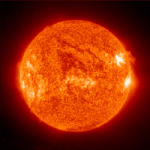LM-NE-03
A star system in the northern section of the sector, it was surveyed and claimed by the Lorath Matriarchy in late YE 34 but not colonized. During the unmanned survey and mapping of the system there was no evidence found of any civilization inhabiting the star system in the past. It was found however that the third and fourth planets are habitable enough for colonization.
Star
Planets
LM-NE-03 I
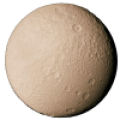 A small airless rocky world that has the closest orbit in the system, it is more or less a lifeless barren cratered world with little of interest. At most it is estimated the planet may have a moderate yield of precursor ores for industrial exploitation.
A small airless rocky world that has the closest orbit in the system, it is more or less a lifeless barren cratered world with little of interest. At most it is estimated the planet may have a moderate yield of precursor ores for industrial exploitation.
| Planet type | Tidally Locked, Airless, Low-G | |
| Distance from primary star | 0.327 AU | |
| Mass | 0.107 Earth masses | |
| Surface gravity | 0.47 Earth gees | |
| Mean Surface temperature | 196.0° Celcius | |
| Normal temperature range | Night: -170.8° C | Day: 398.4° C |
| Equatorial radius | 3059.6 Km (0.48 Earth radii) | |
| Density | 0.97 Earth densities | |
| Eccentricity of orbit | 0.252 | |
| Escape Velocity | 5.3 Km/sec | |
| Axial tilt | 22° | |
| Length of year | 68.39 Earth days | |
| Length of day | 980.72 hours | |
LM-NE-04 II
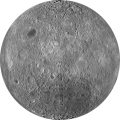 Like its closer brother, the second planet has little to nothing of value and is more or less a hot lifeless rock.
Like its closer brother, the second planet has little to nothing of value and is more or less a hot lifeless rock.
| Planet type | Tidally locked, airless | |
| Distance from primary star | 0.597 AU | |
| Mass | 0.410 Earth masses | |
| Surface gravity | 0.73 Earth Gees | |
| Mean Surface temperature | 74.3° Celcius | |
| Normal temperature range | Night: -227.9° C | Day:253.6° C |
| Equatorial radius | 4763.1 Km (0.75 Earth Radii) | |
| Density | 0.98 Earth densities | |
| Eccentricity of orbit | 0.077 | |
| Escape Velocity | 8.3 Km/sec | |
| Axial tilt | 20° | |
| Length of year | 168.32 Earth days | |
| Length of day | 4039.78 hours | |
LM-NE-04 III
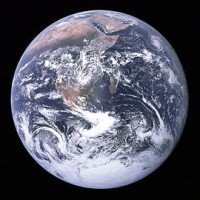 The third planet in the star system, it represents the most habitable with a warm hospitable world with a naturally occurring mild climate. The planet seems to be going through a warming phase with vast tropical jungles covering most of the planet far past the equator or what would even be considered temperate on most worlds. Both poles have small receding ice caps. Two fractured continental bodies compose the main landmasses along with vast tropical archipelagos.
The third planet in the star system, it represents the most habitable with a warm hospitable world with a naturally occurring mild climate. The planet seems to be going through a warming phase with vast tropical jungles covering most of the planet far past the equator or what would even be considered temperate on most worlds. Both poles have small receding ice caps. Two fractured continental bodies compose the main landmasses along with vast tropical archipelagos.
| Planet type | Terrestrial Habitable, Thick Breathable Atmosphere, Warm and Wet |
| Distance from primary star | 0.951 AU |
| Mass | 1.581 Earth masses |
| Surface gravity | 1.17 Earth gees |
| Surface Pressure | 2.498 Earth atmospheres |
| Mean Surface temperature | 28.1° Celcius |
| Normal temperature range | Night: 23.2° C Day:32.7° C |
| Equatorial radius | 7399.9 Km (1.2 Earth radii) |
| Density | 1 Earth densities |
| Eccentricity of orbit | 0.062 |
| Escape Velocity | 13.1 Km/sec |
| Atmospheric Gas Content | Nitrogen 83.9%, Oxygen 15.7%, Argon 0.4% |
| Axial tilt | 15° |
| Length of year | 338.58 Earth days |
| Length of day | 14.48 hours |
| Hydrosphere percentage | 83.4% |
| Cloud cover percentage | 82.7% |
| Ice cover percentage | 1.0% |
LM-NE-04 IV
Slightly cooler then the third planet, the fourth planet in the star system none the less features a breathable atmosphere. However unlike the third almost all of this planet's landmass is submerged beneath a vast ocean. A large number of island groups make up whats left of the planet's landmass. These islands seem to possess an arctic style ecosystem due to the planets further distance and as a result colder temperatures.
| Planet type | Oceanic, Cold, Thick Breathable Atmosphere |
| Distance from primary star | 1.548 AU |
| Mass | 2.388 Earth masses |
| Surface gravity | 1.36 Earth gees |
| Surface pressure | 5.701 Earth atmospheres |
| Mean Surface temperature | 8.3° Celcius |
| Normal temperature range | Night: -4.0° CDay:20.1° C |
| Equatorial radius | 8448.6 Km (1.3 Earth radii) |
| Density | 1 Earth densities |
| Eccentricity of orbit | 0.016 |
| Escape Velocity | 15.0 Km/sec |
| Axial tilt | 33° |
| Length of year | 703.69 Earth days |
| Length of day | 13.13 hours |
| Atmospheric Gas Content | Nitrogen 63.5%, Oxygen 36%, Trace gases |
| Hydrosphere Percentage | 96.6% |
| Cloud Cover Percentage | 45.3% |
| Ice Cover Percentage | 4% |
LM-NE-04 V
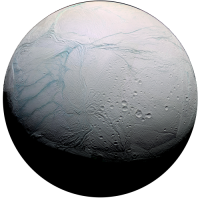 While it does have a significant atmosphere, the large presence of saturated hydrogen renders in unbreathable to normal humans. For the most part the fifth planet is nothing more then a large arid ball of ice.
While it does have a significant atmosphere, the large presence of saturated hydrogen renders in unbreathable to normal humans. For the most part the fifth planet is nothing more then a large arid ball of ice.
| Planet type | Cold, Icy, Arid, Cloudless |
| Distance from primary star | 1.879 AU |
| Mass | 1.172 Earth masses |
| Surface gravity | 1.06 Earth gees |
| Surface pressure | 1.374 Earth atmospheres |
| Mean Surface temperature | -100.8° Celcius |
| Normal temperature range | Night:-103.1° C Day:-98.7° C |
| Equatorial radius | 6717.2 Km (1.1 Earth radii) |
| Density | 1 Earth densities |
| Eccentricity of orbit | 0.082 |
| Escape Velocity | 11.8 Km/sec |
| Axial tilt | 28° |
| Length of year | 940.75 Earth days |
| Length of day | 14.90 hours |
| Atmospheric Gas Content | Nitrogen 60.5%, Hydrogen 20.2%, Oxygen 18.5% |
| Cloud Cover Percentage | 0.2% |
| Ice Cover Percentage | 100.0% |
LM-NE-04 VI

| Planet type | Cold, Icy, Arid, Cloudless |
| Distance from primary star | 3.152 AU |
| Mass | 1.146 Earth masses |
| Surface gravity | 1.05 Earth gees |
| Surface pressure | 1.314 Earth atmospheres |
| Mean Surface temperature | -140.5° Celcius |
| Normal temperature range | Night:-142.3° C Day:-138.8° C |
| Equatorial radius | 6668.2 Km (1 Earth Radii) |
| Density | 1 Earth densities |
| Eccentricity of orbit | 0.009 |
| Escape Velocity | 11.7 Km/sec |
| Axial tilt | 33° |
| Length of year | 2043.52 Earth days |
| Length of day | 14.95 hours |
| Atmospheric Gas Content | Nitrogen 40.5%, Hydrogen 38.2%, Oxygen 15.2%, Helium 7.05% |
| Ice Cover Percentage | 100% |
LM-NE-04 VII
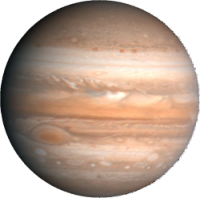
| Planet type | Jovian Gas Giant |
| Distance from primary star | 4.746 AU |
| Mass | 456.334 Earth masses |
| Equatorial radius | 71953.7 Km (11 Earth Radii) |
| Density | 0.32 Earth densities |
| Eccentricity of orbit | 0.066 |
| Escape Velocity | 71.1 Km/sec |
| Axial tilt | 19° |
| Length of year | 3773.49 Earth days |
| Length of day | 6.89 hours |
| Atmospheric Gas Content | Hydrogen, Helium, Nitrogen, Methane |
| Moons | 8 Large, 10 Medium, 20 captured asteroids |
LM-NE-04 VIII

| Planet type | Jovian |
| Distance from primary star | 11.882 AU |
| Mass | 595.323 Earth masses |
| Equatorial radius | 83935.7 Km (13 Earth radii) |
| Density | 0.26 Earth densities |
| Eccentricity of orbit | 0.061 |
| Escape Velocity | 75.2 Km/sec |
| Axial tilt | 36° |
| Length of year | 14945.79 Earth days |
| Length of day | 7.04 hours |
| Atmospheric Gas Content | Hydrogen, Helium, Nitrogen, Methane |
| Moons | 2 Large, 4 Medium, 10 captured asteroids |
LM-NE-04 IX
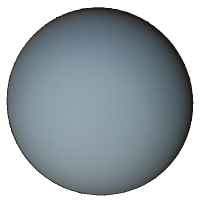
| Planet type | Sub Jovian |
| Distance from primary star | 16.282 AU |
| Mass | 4.617 Earth masses |
| Equatorial radius | 3.3 Earth radii |
| Density | 0.13 Earth densities |
| Eccentricity of orbit | 0 |
| Escape Velocity | 13.3 Km/sec |
| Axial tilt | 25° |
| Length of year | 23995.89 Earth days |
| Length of day | 19.89 hours |
| Atmospheric Gas Content | Hydrogen, Helium, Nitrogen, Methane |
| Moons | 3 Large, 1 medium, 5 captured asteroids |
LM-NE-04 X
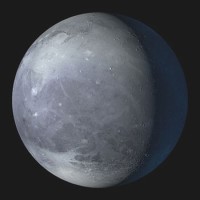
| Planet type | Rocky Low-G, Cold, Airless |
| Distance from primary star | 39.360 AU |
| Mass | 0.109 Earth masses |
| Surface gravity | 0.26 Earth gees |
| Mean Surface temperature | -231.2° Celcius |
| Normal temperature range | Night:-236.6° C Day:-225.8° C |
| Equatorial radius | 4105.6 Km (0.64 Earth radii) |
| Density | 0.41 Earth densities |
| Eccentricity of orbit | 0.117 |
| Escape Velocity | 4.6 Km/sec |
| Axial tilt | 46° |
| Length of year | 90196.17 Earth days |
| Length of day | 29.90 hours |
LM-NE-04 XI

| Planet type | Low-G, Cold, Icy, Arid, Cloudless, Unbreathably thin atmosphere |
| Distance from primary star | 41.773 AU |
| Mass | 0.570 Earth masses |
| Surface gravity | 0.46 Earth gees |
| Surface pressure | 0.081 Earth atmospheres |
| Mean Surface temperature | -231.2° Celcius |
| Normal temperature range | Night: -233.8° CDay:-228.7° C |
| Equatorial radius | 7077.0 Km (1.1 Earth Radii) |
| Density | 0.42 Earth densities |
| Eccentricity of orbit | 0.004 |
| Escape Velocity | 8.0 Km/sec |
| Axial tilt | 45° |
| Length of year | 98613.70 Earth days |
| Length of day | 22.50 hours |
| Atmospheric Gas Content | Trace amounts of hydrogen, helium, and nitrogen |
| Places of the SARPiverse |
| Place Categories | star system |
| Risk Level | low |
 A small airless rocky world that has the closest orbit in the system, it is more or less a lifeless barren cratered world with little of interest. At most it is estimated the planet may have a moderate yield of precursor ores for industrial exploitation.
A small airless rocky world that has the closest orbit in the system, it is more or less a lifeless barren cratered world with little of interest. At most it is estimated the planet may have a moderate yield of precursor ores for industrial exploitation.
 Like its closer brother, the second planet has little to nothing of value and is more or less a hot lifeless rock.
Like its closer brother, the second planet has little to nothing of value and is more or less a hot lifeless rock.
 The third planet in the star system, it represents the most habitable with a warm hospitable world with a naturally occurring mild climate. The planet seems to be going through a warming phase with vast tropical jungles covering most of the planet far past the equator or what would even be considered temperate on most worlds. Both poles have small receding ice caps. Two fractured continental bodies compose the main landmasses along with vast tropical archipelagos.
The third planet in the star system, it represents the most habitable with a warm hospitable world with a naturally occurring mild climate. The planet seems to be going through a warming phase with vast tropical jungles covering most of the planet far past the equator or what would even be considered temperate on most worlds. Both poles have small receding ice caps. Two fractured continental bodies compose the main landmasses along with vast tropical archipelagos.
 While it does have a significant atmosphere, the large presence of saturated hydrogen renders in unbreathable to normal humans. For the most part the fifth planet is nothing more then a large arid ball of ice.
While it does have a significant atmosphere, the large presence of saturated hydrogen renders in unbreathable to normal humans. For the most part the fifth planet is nothing more then a large arid ball of ice.
